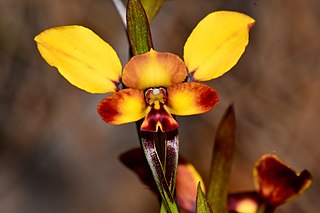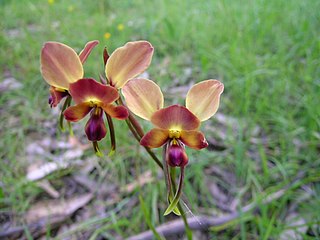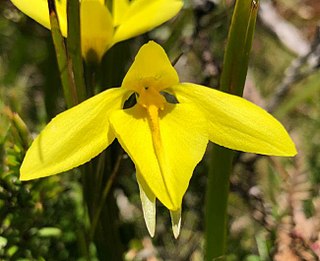Diuris maculata, commonly known as the spotted doubletail is a species of orchid which is endemic to New South Wales. It has up to two or three folded leaves and a flowering stem with up to eight yellow flowers with brown to blackish markings. It is similar to D. pardina which has darker flowers with larger brown markings.
Diuris carinata, commonly known as the tall bee orchid, is a species of orchid that is endemic to the south-west of Western Australia. It has between four and six leaves and up to seven large, bright yellow flowers with reddish-brown markings.

Diuris corymbosa, commonly called the common donkey orchid or wallflower orchid, is a species of orchid which is endemic to the south-west of Western Australia. It is similar to the purple pansy orchid but its flowers are yellow rather than purple or mauve and it flowers earlier in the year. It also resembles the winter donkey orchid but flowers later than that species. It is one of the most common orchid species in the Perth area, often forms extensive colonies and usually has numerous flowers on the one spike.

Diuris porrifolia, commonly called the small-flowered donkey orchid is a species of orchid which is endemic to the south-west of Western Australia. It has two or three leaves and up to seven yellow flowers with brown or reddish markings. It is similar to the common donkey orchid but its flowers are smaller and it has a more easterly distribution.

Diuris sulphurea, commonly called the tiger orchid or hornet orchid, is a species of orchid which is endemic to eastern Australia. It has up to three leaves, and a flowering stem with up to seven bright yellow flowers with dark brown markings.

Diuris orientis, commonly called the wallflower orchid or eastern wallflower orchid, is a species of orchid which is endemic to eastern Australia. Like others in the genus Diuris, it has two ear-like petals and is similar to the common donkey orchid of Western Australia with which it has been confused. This species is found in New South Wales, Victoria, South Australia and Tasmania and its stalk-like petal "claw" is shorter in than those of D. corymbosa.

Microtis arenaria, commonly known as the notched onion orchid, is a species of orchid endemic to south-eastern Australia. It has a single hollow, onion-like leaf and up to sixty scented, crowded yellowish-green flowers. It is widespread and common, growing in a wide variety of habitats.
Diuris brevissima is a species of orchid which is endemic to New South Wales. It has two folded leaves and up to nine light yellow flowers with reddish-brown markings. It is a poorly known species that has only been recorded in the Blue Mountains.
Diuris flavescens, commonly called the pale yellow doubletail or Wingham doubletail, is a species of orchid which is endemic to a small area in New South Wales. It has two linear leaves at its base and up to five pale yellow flowers with dark brown markings. Fewer than 200 plants survive in grassy forest near Wingham.
Diuris heberlei, commonly called Heberle's donkey orchid, is a species of orchid which is endemic to the south-west of Western Australia. It has three to five linear leaves at its base and up to four bright yellow flowers with a reddish brown border around the labellum callus. It is found along the south coast and is one of the last Diuris to flower in Western Australia.

Diuris lanceolata, commonly known as large golden moths, is a species of orchid that is endemic to Tasmania. It has between two and four leaves and up to three golden to orange-yellow flowers with a few dark streaks.
Diuris micrantha, commonly called the dwarf bee orchid or tiny bee orchid, is a rare species of orchid which is endemic to the south-west of Western Australia. It has four to six linear leaves at its base and up to six yellow flowers with reddish brown markings. It grows in swampy places south of Perth.
Diuris luteola, commonly called the northern doubletail, is a species of orchid which is endemic to Queensland. It has a single linear leaf at its base and up to six pale yellow flowers with a few brown markings. It grows in shallow, stony soil on tablelands in eastern parts of the state.
Diuris ochroma, commonly known as pale goat orchid, or pale golden moths is a species of orchid that is endemic to south-eastern continental Australia. It has three or four leaves at its base and up to four slightly drooping pale yellow flowers with dark reddish purple streaks. It is an uncommon species found in two disjunct populations, in higher parts of each of New South Wales and Victoria.

Diuris palustris, commonly known as the swamp doubletail or swamp diuris is a species of orchid which is endemic to south-eastern Australia. It has a tuft of between eight and ten twisted leaves and up to four yellow flowers with brown spots and blotches marks and blotches.
Diuris platichila, commonly known as the Blue Mountains doubletail, is a species of orchid that is endemic to a few isolated places in the Blue Mountains in New South Wales. It has two leaves and up to eight yellow flowers with dark markings on the dorsal sepal and labellum. It has relatively long, thin lateral sepals and the central lobe of the labellum is wedge-shaped. It forms hybrids with other species of Diuris.

Diuris semilunulata, commonly known as the late leopard orchid, is a species of orchid that is endemic to New South Wales and the Australian Capital Territory. It has two grass-like leaves and up to five orange-coloured flowers with brown and purple blotches.
Diuris striata is a poorly-known species of orchid that is endemic to New South Wales. It has a two grass-like leaves and about four mauve flowers with dark purple streaks on the labellum.
Diuris tricolor, commonly known as the long-tailed donkey orchid or pine donkey orchid, is a species of orchid that is endemic to New South Wales, although a single plant has been found in Victoria. It has up to three grass-like leaves and up to six orange-coloured to yellow flowers with white and purplish tints. The lateral sepals are unusually long.

Calochilus herbaceus, commonly known as the pale beard orchid, is a species of orchid native to south-eastern Australia and northern New Zealand. It has a single very short, rigid, fleshy leaf and up to eight pale green to brownish flowers with reddish stripes and a purple "beard".












